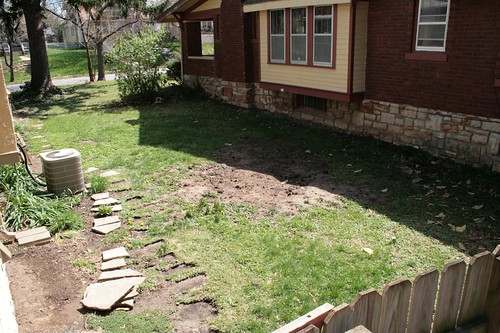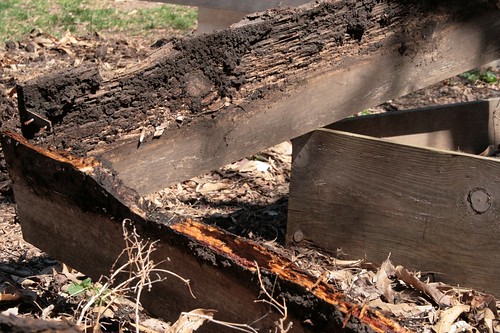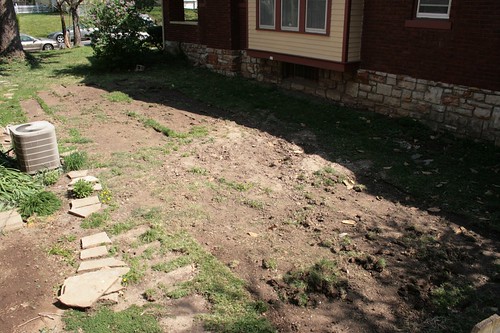
Back in December, I discussed my plan to move the vegetable garden from the backyard to the space on the south side of our house. This spring we've been working hard to turn plans into reality, in spite of circumstances intervening and things going slower then planned.
In March, Rob dug up the forsythia, which ended up taking a couple of hours and a sledge hammer. The results left a nice little pit of dirt and at last no stump to contend with:

After that was done, I pulled up the old beds we built back in 2007 and took a look at the boards. My assumption was that the bottom portions would have some decay but would be otherwise usable in the new plot, so I was a little surprised by the severity of the decay on some of the boards. Here's a photo to illustrate what I'm talking about:

The heaviest decay occurred on the boards further downhill, which is lightly shaded throughout much of the shade and obviously gets more water when it rains. It's also worth mentioning that we built the beds with 1"x8" untreated pine boards. After 3 seasons in-ground, some decay is to be expected. Less expected were the termites that infested 2 or 3 of the boards; our house suffered minor termite damage in the distant past, but we've never seen any sign of the critters. When I first discovered all this, I was afraid we wouldn't be able to reuse the boards at all, but after further assessing the damage, we were able to salvage half for use on the small 2'x2' and 2'x4' frames. Not bad!
For the rest of the boxes, we settled on untreated pine 2"x6" boards, which would give us a good bed height without having to double them up. Initially, I considered the more rot-resistant cedar, but it wasn't as cost-effective. In theory, the sunniness of the new spot and the thicker weight of the boards should help stave off decay longer than in the previous plot.
But before we actually built the frames, it was onto the new step, which was clearing out the grass. Originally I considered doing what a lot of raised bed gardeners do, which is starting right on top of the grass and blocking out weeds with cardboard, newspaper, or landscaping fabric. We'd lay some cardboard along the paths to kill the grass and eventually lay some pebbles or mulch. This idea wasn't really that great, though, since it would end up diverting more water down the path, which would pool up near the gate. Not cool. So we decided that removing an inch or two of sod would be a better idea.
Last weekend we rented a sod cutter and spent an hour or so ripping out lawn:

A bit of a spotty job, but nothing a shovel can't fix.
The last step was building the frames and installing them, which takes more effort than you can imagine. It's hard to tell in photos, but the south yard slopes ever-so-slightly, necessitating the leveling of each bed. Once this task was finished, we broke up the remaining layer of soil (mostly clay), removed offending root masses, and brought in the wonderful soil from the original vegetable garden that took 3 years and a lot of compost to build. We ended up having lots left for the future woodland garden, the backbone of which we'll start building in another week or two.
While the renovated vegetable garden has gone brilliantly, I've had an awful time with seedlings and have lost most while in the cold frame. It does a terrific job trapping in heat during the hottest parts of the day but seems not quite able to block out the frost. 2 weeks ago we had a few nights when the temperatures dropped near freezing, effectively killing the bulk of my seedlings. It's also possible that I have not left the cover on long enough to generate the necessary heat. Whatever the issue, I'm going to try and work it out before autumn, so I'm able to extend my crop a bit longer than usual. I look forward to the challenge!